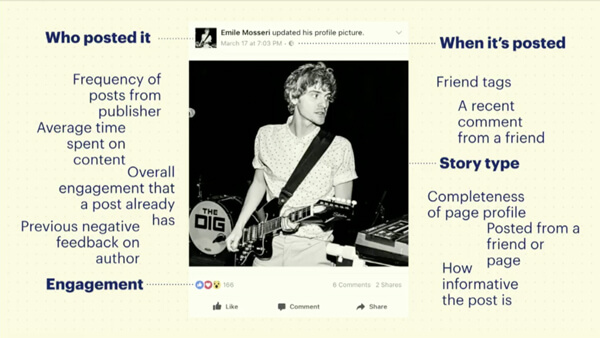 Are your posts reaching fewer people on Facebook?
Are your posts reaching fewer people on Facebook?
Wondering how to appear in more people's news feeds?
Facebook's algorithm dictates who sees your content and who doesn't.
In this article, you'll discover how the Facebook algorithm works, and how marketers can optimize their posts for maximum news feed visibility.

#1: How Facebook's News Feed Algorithm Ranks Your Content
Adam Mosseri (VP, News Feed at Facebook) recently broke down the four steps Facebook uses to rank your content in the news feed during 2017's F8 Summit.
He first explained that an algorithm is “a formula or set of steps for solving a particular problem.” He then presented a real-world problem to illustrate how it works; specifically, what to order his wife at a restaurant.
To find a solution, Adam breaks this problem down into four steps:
- He checks the menu to see what his options are.
- He considers all of the information at his disposal (e.g., what does his wife like to eat, is it lunch or dinner time, what's good at the restaurant?).
- From there, he makes lightweight predictions in his head (e.g., would she enjoy having salmon for lunch today, would it be weird if I ordered her a chocolate soufflé for breakfast?).
- He then has to consider all of this information and place his wife's order.
By activating this process, Adam is executing an algorithm in his head. Which is what we all do every day. Similarly, Facebook's algorithm uses four steps to help it decide how to rank your content in the news feed.

Those steps are:
- Inventory (What's on the menu?)
- Signals (Is it lunch or dinner time?)
- Predictions (Would she enjoy the salmon?)
- Score (Place an order.)
Inventory
When you first open your news feed, Facebook's algorithm takes an inventory by looking at all of the stories posted by your friends and the pages you follow (in the same way Adam checked to see what was on the menu).
Signals
Facebook then considers all available data and tries to make an informed decision about how interested you may be in a certain story. Facebook calls this data “Signals”. There are hundreds of thousands of them that Facebook considers to rank your content, such as who posted a story, what phone a user is on, what time it is right now, how much bandwidth you have, and so on. (More on these signals below.)
Get World-Class Marketing Training — All Year Long!
Are you facing doubt, uncertainty, or overwhelm? The Social Media Marketing Society can help.
Each month, you’ll receive training from trusted marketing experts, covering everything from AI to organic social marketing. When you join, you’ll also get immediate access to:
- A library of 100+ marketing trainings
- A community of like-minded marketers
- Monthly online community meetups
- Relevant news and trends updates
Predictions
Facebook then uses these signals to help make predictions and calculate the probability of certain outcomes; for example, how likely you are to comment on a story, share a story, spend time reading a story, and so forth.

Score
After making these predictions and calculating the probabilities, Facebook consolidates the information to calculate a “relevance score,” a number that represents how interested Facebook thinks you may be in a certain story. It's worth noting that Adam made a point of stressing that Facebook doesn't really know how interested you are in a certain story; it's an educated guess at best.

This ranking process occurs each and every time you open Facebook, and ultimately determines what your feed looks like.

#2: The Signals Facebook Considers When Ranking Your Content
One massive takeaway from Adam's keynote was “the most critical input into what you see in your news feed is who you decide to friend and what [pages] you decide to follow in the first place.”
This makes sense, as these critical inputs will largely determine how Facebook interprets the myriad of signals it looks at when ordering a news feed that's most relevant to your interests.
Some of the specific signals that will affect your ranking on Facebook include:
Who posted a story
- Frequency of posts from that person / publisher
- Previous negative feedback on an author
Engagement
- Average time spent on content
- Overall engagement a post already has

When the story was posted

Discover Proven Marketing Strategies and Tips
Want to go even deeper with your marketing? Check out the Social Media Marketing Podcast! Publishing weekly since 2012, the Social Media Marketing Podcast helps you navigate the constantly changing marketing jungle, with expert interviews from marketing pros.
But don’t let the name fool you. This show is about a lot more than just social media marketing. With over 600 episodes and millions of downloads each year, this show has been a trusted source for marketers for well over a decade.
- Friend tags
- A recent comment from a friend
Story type
- Completeness of page profile
- Posted from a friend or page
- How informative the post is
#3: The Predictions Facebook Makes When Ranking Your Content
Facebook takes into account each user's network of friends, the pages they follow, and the signals above to make a series of predictions and probabilities, namely the likelihood:
- to click.
- to spend time with a story.
- to like, comment, and share.
- you'll find it informative.
- this is click bait.
- this contains nudity.
This results in a relevance score, and thus a news feed that's unique to every person on Facebook.

#4: How to Optimize Your Content for the Facebook Algorithm
As marketers, you always want your content to be seen by as many people as possible, especially now that there's more noise than ever before. Adam's recent keynote has reinforced just how important it is to create content that's relevant, valuable, and interesting for your target audience. If you don't do this, it's likely you'll appear in fewer news feeds.
The following list of tips will help you create content that reaches as many news feeds as possible (based on the insights from Adam's keynote above):
Maintain a Facebook page that minimizes negative feedback from users over its life span. Proofread your copy and double-check your links before posting to your page.
Create content likely to elicit positive feedback from your audience, in the form of positive comments, likes, or reactions, which are now weighted so they affect post ranking slightly more than likes.

Publish content that promotes engagement and an investment of time from your audience; video content is an excellent option here.
Post content that's social and shareable, like this visual post from The Awkward Yeti.

Create posts that are likely to result in your audience liking, commenting, and sharing with their friends. This post from Silverwood Theme Park was shared over 500 times in just 6 hours.

Create posts that are likely to result in people clicking on your links, photos, copy, videos, and other content. This post from Travel & Leisure prompts anyone who's looking for a good deal on an island getaway to click and learn more.
Maintain a consistent content schedule.

Build an audience and following that are relevant to your overarching goals as a business, and create content that maps to those goals. You can check the makeup and interests of your Facebook page's audience using Audience Insights and selecting the People Connected to Your Page option.

Tactics to Stay Away From
- Don't create content that misleads or misrepresents itself to users (i.e., no click bait).
- Don't create content that violates Facebook's Terms & Conditions (e.g., no nudity).
Final Thoughts
Remaining visible in the news feed will continue to become more challenging as the amount of noise on Facebook continues to increase. That's why it's now more important than ever to focus on creating relevant content that your audience will welcome in their news feeds. If you can continue to give your audience content they find relevant and enjoyable, it appears Facebook will continue to show your content in their news feeds.
What do you think? What are you doing to improve visibility in the Facebook news feed? Please share your thoughts in the comments below.

Attention Agency Owners, Brand Marketers, and Consultants

Introducing the Marketing Agency Show–our newest podcast designed to explore the struggles of agency marketers.
Join show host and agency owner, Brooke Sellas, as she interviews agency marketers and digs deep into their biggest challenges. Explore topics like navigating rough economic times, leveraging AI, service diversification, client acquisition, and much more.
Just pull up your favorite podcast app, search for Marketing Agency Show and start listening. Or click the button below for more information.

